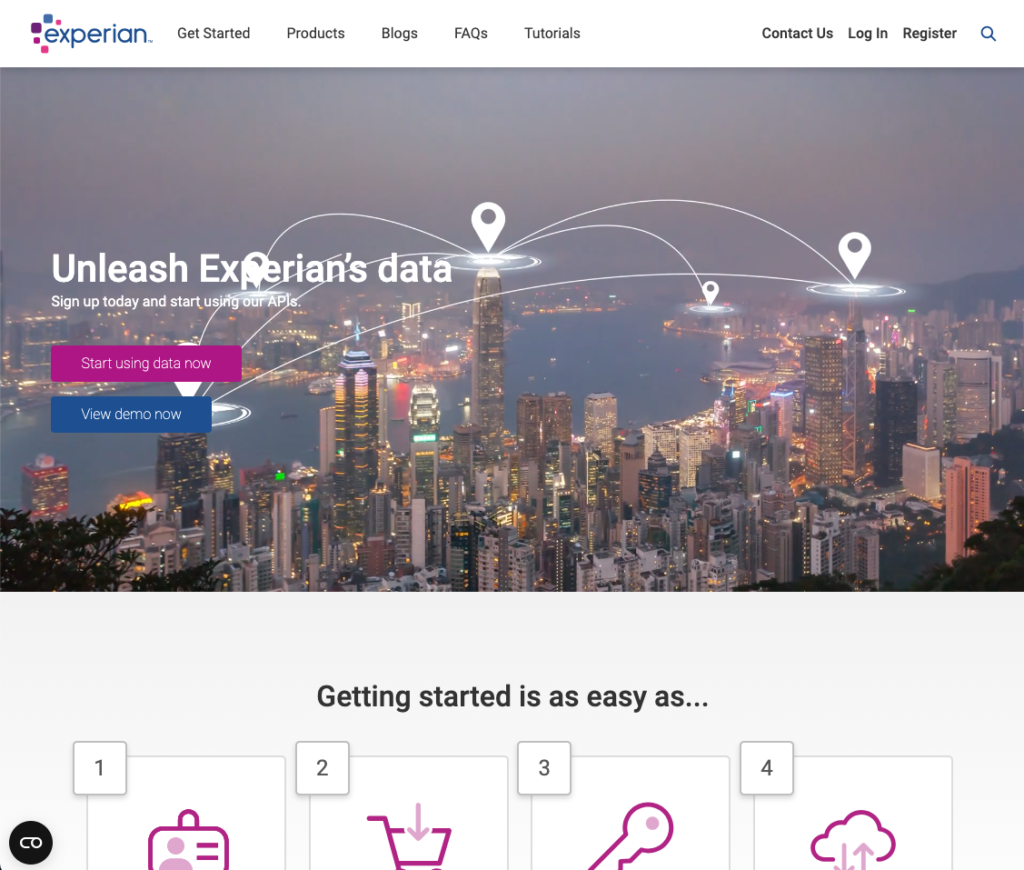In early 2016, Experian PLC, a global information services group started working on a global website for their API technologies. this would be a place for developers to find, license, and use Experian’s APIs. As the UX Team of One in a small contracting team within a large enterprise, this project was one of my most challenging ones yet.
Live website: http://developer.experian.com

The challenge:
Experian PLC consists of 8 business units all over the world with operations in 40 countries, and has over 120 products. The APIs currently in use were in the process of being rewritten to a mode modern RESTful standard, and more were planned to be developed in the coming months. Perhaps the most challenging part of this project was that I only had three months to work on it.
Primary Goals:
– Consolidate categorization schema across different products, business units in the different countries that Experian PLC operates in.
– Develop visual designs that conformed to old guidelines, as well as the upcoming rebranding guidelines.
– Hypothesize and validate user needs from a developer portal
– Design an information architecture to support exploration and discovery of API products
Secondary goals:
– Collect FAQ, Blog, and Support content from respective product owners.
– Assist developers with development of website in Drupal
– Implement and manage project scrum duties
How I did it:
Scrum Implementation:
One of the first things I did for the project was to establish a daily standup ritual, and make a move to implement scrum for project management. My past experience made me most suitable for the role, and once planning was done, the project was much easier to work with for all team members. My past experience working at RightScale allowed me to effectively implement a flavor of agile inspired by scrum that improved our project health dramatically.
Consolidate categorization schema:
Experian PLC is a company that has primarily grown through mergers and acquisitions around the world. This resulted more than half a dozen categorization schema. These schema were driven by different ideas such as business needs, sales, marketing, product, regional offerings etc.
After gathering all the categories I could find, I conducted a series of card sorting exercises with four product owners from three business units from the US and UK regions, and three developers who have previously worked with building customized software using Experian’s existing API technologies.
This covered the categorization for 90% of all of Experian’s global product offerings.
While there was no direct one to one relationship between Experian’s API offerings and their products, the absence of functional APIs made it impossible to determine categories for the APIs. The thought was that most APIs will be developed to replicate functionality offered by one or more API product, and could “inherit” their categorization tags accordingly.

The categorization was a success, but concerns about missing information from product managers from other regions of operation prevented me from giving a go-ahead for it’s full implementation.
Requesting access to these product managers was outside of the scope of the project, and I found it prudent to implement a categorization schema that was not too far from the existing product capability driven schema that Experian uses in some of it’s marketing material.
This was vital so as to not confusing existing Experian Customers, as well as save on the potential confusion in the support channels who may not have time to be trained about the new categorization schema in time for the launch of the website.
The categorization schema developed as a result of the card sorting exercises are currently being considered by Experian PLC for possible implementation next year.
Visual design work:
Experian PLC had an undocumented current visual design, as well as an upcoming visual identity rebranding that was set to go live in December, a few weeks after the launch of developer portal.
For this reason, two sets of visual designs had to be developed for the developer portal.
The designs were created in Sketch, and made into clickable prototypes using InvisionApp. Click the thumbnails to view the prototypes.
01-home-122x
v2 (with new branding guidelines)
Hypothesize and validate user needs:
The short timeline for the project, coupled with extreme difficulty accessing Experian’s own customers meant that conducting a traditional user study with my designs would be near impossible.
For this reason, I anonymized my designs and conducted informal usability studies five developers of my acquaintance. I also conducted my study with three Experian product managers and two developers. By comparing the responses from these participants, I was able to make better decisions about my design.
The usability study was a moderated , think out loud session where participants were asked to perform basic functions on the portal such as search for an API, find an API without using search. There was also a guided feedback session about the functionality of the portal.
Design Information Architecture:
The information architecture of the developer portal was largely developed using mind maps and Do-Go maps. Conversations with Experian product managers and usability testing of interactive prototypes shaped the final implementation of Information Architecture used on the website.
Usability studies were think-out-loud style semi guided task based exercises conducted with the product managers (mostly as means of building empathy for user needs with the upper management) and with API developers that fit our persona profiles.
Collect FAQ, Blog, and Support content:
The initial launch of the website would feature 6 APIs from one business unit each from the US and UK. Product managers, as well as content creators from the business units were contacts well in advance of the launch date to collect the required content. The collected content was run by the marketing and legal teams, to ensure that the material did not conflict with any guidelines that our team was unaware of. The content was collected, approved, and published in time for the launch of the first phase of the website.
Assist developers with development of website in Drupal
My experience developing websites allowed me to contribute to the development of the website. I helped implement the information architecture schema and taxonomy in the Drupal backend.
I was also part of QA-ing the css on the website during it’s initial development phase.
Project Launch
The first phase of the website went live mid-December 2015, with the next phase release dependent on the API development progress of various business units. Although my contract ended before the website went live, I had documented my designs in sufficient detail to allow the team to implement them without any hiccups. The portal has been developed to allow for easy upgrades to incorporate future API products as they were developed, as well as for the restructuring of the Information Architecture of the website which is inevitable as the complexity increases.

